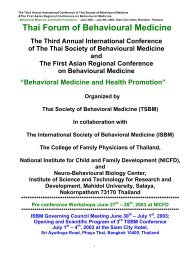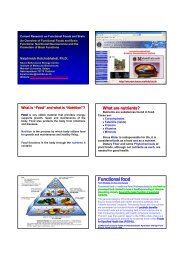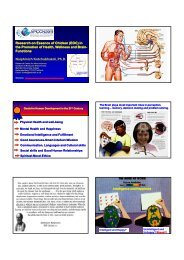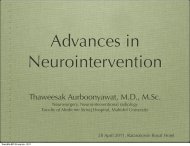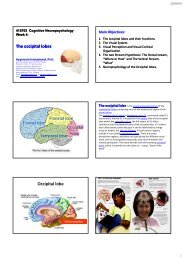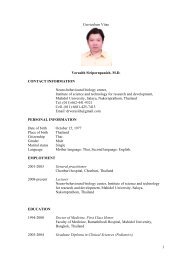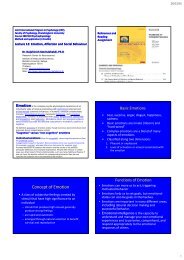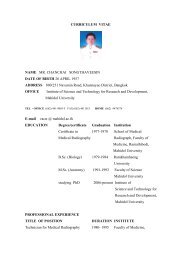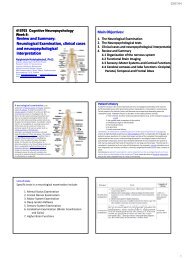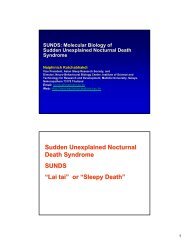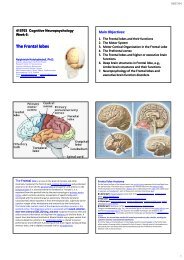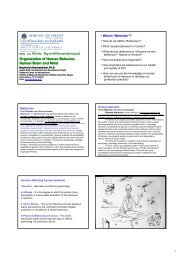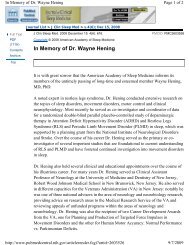PDF File - Mahidol University
PDF File - Mahidol University
PDF File - Mahidol University
You also want an ePaper? Increase the reach of your titles
YUMPU automatically turns print PDFs into web optimized ePapers that Google loves.
386<br />
Abstracts<br />
Our studies using several cognitive tasks have indicated that<br />
peak activation in the processing of Chinese characters was<br />
located in the left middle frontal cortex (BA 9 and 46),<br />
regions that previous investigations with English and other<br />
alphabetic languages have not commonly identified. Because<br />
the left middle frontal cortex is known to subserve visualspatial<br />
processing of objects and spatial working memory, we<br />
have hypothesized that its extremely strong activation in<br />
reading Chinese is associated with the unique square configuration<br />
of characters. We further found that when Chinese-<br />
English bilinguals process English words phonologically, the<br />
left middle frontal cortex is most strongly activated. This<br />
suggests that the processing of Chinese phonology (where<br />
logographic characters are pronounced monosyllabically and<br />
do not call for phonemic parsing) carries over to second<br />
language processing. Finally, in a study with Chinese<br />
dyslexics, we found less middle frontal and temporal activations<br />
for dyslexic children, suggesting that they were facing a<br />
great difficulty in phonological processing.<br />
WS-3-3<br />
Specific learning disabilities (SLD): advocacy<br />
C.-W. Chan<br />
Working Party on SLD, The Hong Kong Society of Child<br />
Neurology and Developmental Paediatrics (HKCNDP),<br />
Hong Kong, China<br />
With advancement in our understanding of the neurobiological<br />
bases, clinical features and evidence-supported<br />
interventions for SLD, it is imperative that services for<br />
and interests of affected individuals are safeguarded accordingly.<br />
These are rights embodied under the UN Charter for<br />
Children’s Rights. In order to achieve these we need alignment<br />
of definitions among professionals, accurate identification<br />
and diagnosis through powerful screening and<br />
assessment tools and integrated multidisciplinary teams, as<br />
well as specific and accountable management plans. In line<br />
with these, there must be parents who understand their children’s<br />
condition and needs, school teachers who have<br />
appropriate preparation and ongoing in-service training,<br />
enlightened education administrators, as well as wide spread<br />
public awareness and acceptance of the disabilities. Adverse<br />
complications associated with undiagnosed or improperly<br />
managed children with SLD include school failure and<br />
drop out, eroded self esteem, juvenile delinquency,<br />
substance abuse, and a future life of unemployment and<br />
underachievement. Effective legislation and government<br />
policies, plus close partnerships between professionals,<br />
stakeholders and the public are foundations for success.<br />
Given the range of information and services that address<br />
the full scope of SLD and appropriate measures to promote<br />
their talents and potentials, every individual with SLD will<br />
have the opportunity to lead a productive and fulfilling life,<br />
from which society will ultimately benefit.<br />
WS-3-4<br />
Clinical diagnosis and management<br />
C.C.C. LAM<br />
Central Kowloon Child Assessment Centre, Kowloon, Hong<br />
Kong, China<br />
Abstract not submitted<br />
FREE PAPERS-Oral Presentation<br />
FO-1<br />
Neuroscience<br />
FO-1-1<br />
Effects of developmental lead exposure on nitric oxide<br />
synthase activity in different brain regions of rat<br />
G.-J. Dong, Z.-Y. Zhao, Z.-W. Zhu<br />
The Affiliated Children’s Hospital of Zhejiang <strong>University</strong><br />
School of Medicine, Hangzhou, China<br />
Objective: To observe the influence of lead exposure on<br />
nitric oxide synthase (NOS) in different brain regions of rat.<br />
Methods: By establishing a series of rat models exposed to<br />
different low levels lead during developing period, (drinking<br />
water containing 0.025, 0.05 and 0.075% lead acetate) we<br />
studied NOS activity in hippocampus, cerebellum, cerebral<br />
cortical and brain stem. Results: For 0.025 and 0.05% groups,<br />
NOS activity in hippocampus was obviously inhibited, had<br />
significant difference with that in cerebral cortical and brain<br />
stem (P , 0:05). For 0.075% group, NOS activity in cerebral<br />
cortical was obviously lower than those in hippocampus and<br />
brain stem (P , 0:05). On the 21st and 28th day after birth,<br />
NOS activity in cerebellum of 0.025 and 0.05% groups was<br />
lower than those in hippocampus, cerebral cortical and brain<br />
stem (P , 0:05), while NOS activity in cerebellum of<br />
0.075% group was lower than those in hippocampus and<br />
brain stem (P , 0:05). On the 21st and 28th day after birth,<br />
NOS activity in hippocampus and cerebellum of each experiment<br />
group was obviously lower than that of control group<br />
(P , 0:01). On different time points, NOS activity in Cerebral<br />
cortical of 0.075% group was obviously lower than that<br />
of control, 0.025 and 0.05% groups (P , 0:05). Lead exposure<br />
had no influence on NOS activity in brain stem<br />
(P . 0:05). Conclusions: NOS activities in hippocampus,<br />
cerebral cortical and cerebella cortical of rat were inhibited<br />
by lead exposure and the degree of the effect was related to Pb<br />
exposure time and level of Pb.<br />
FO-1-2<br />
Developing cortical neurons injury following recurrent<br />
epileptiform discharges induced by magnesium-free<br />
culture<br />
H.-Y. Cao, Y.-W. Jiang, T. Bo, X.-R. Wu<br />
Division of neurology, Department of Pediatrics, Peking<br />
<strong>University</strong> First Hospital, Beijing, China



